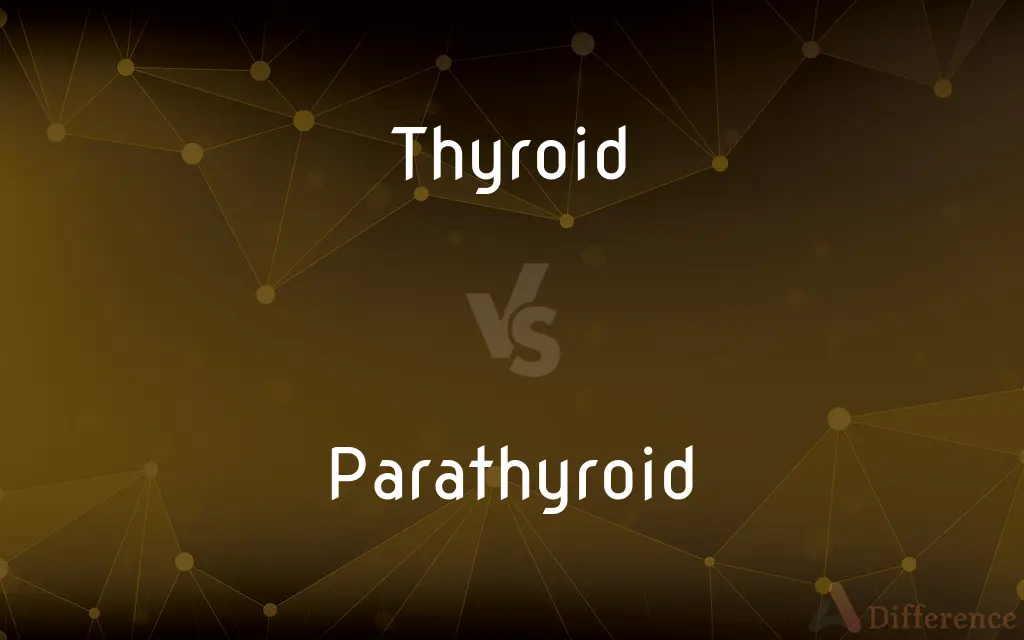Thyroid vs. Parathyroid — What's the Difference?
By Tayyaba Rehman & Maham Liaqat — Updated on May 16, 2024
The thyroid is a butterfly-shaped gland located in the neck, regulating metabolism and energy through hormone production, while the parathyroid consists of four small glands near the thyroid, controlling calcium levels in the blood and bones.

Difference Between Thyroid and Parathyroid
Table of Contents
ADVERTISEMENT
Key Differences
The thyroid gland, located at the front of the neck, produces hormones such as thyroxine (T4) and triiodothyronine (T3) that regulate metabolism, energy levels, and overall growth and development. The parathyroid glands, typically four in number, are small and located behind the thyroid gland. They produce parathyroid hormone (PTH), which is essential for regulating calcium and phosphate balance in the blood and bones.
While the thyroid gland's primary function is to regulate the body's metabolism, the parathyroid glands are specifically focused on calcium homeostasis. Disorders of the thyroid, such as hypothyroidism or hyperthyroidism, affect metabolic processes, whereas disorders of the parathyroid, such as hyperparathyroidism, primarily impact calcium levels and bone health.
The thyroid gland responds to signals from the pituitary gland to release its hormones, while the parathyroid glands respond directly to the calcium levels in the blood to release PTH. This distinction highlights their different regulatory mechanisms and functions in the endocrine system.
In terms of medical conditions, thyroid issues are often related to hormonal imbalances affecting weight, energy, and mood. Parathyroid issues usually involve calcium imbalances leading to symptoms like muscle cramps, bone pain, and kidney stones.
Comparison Chart
Location
Front of the neck, butterfly-shaped
Behind the thyroid, typically four glands
ADVERTISEMENT
Main Hormones
Thyroxine (T4), Triiodothyronine (T3)
Parathyroid hormone (PTH)
Primary Function
Regulates metabolism, energy levels
Controls calcium and phosphate levels
Responds to
Pituitary gland signals
Blood calcium levels
Common Disorders
Hypothyroidism, Hyperthyroidism
Hyperparathyroidism, Hypoparathyroidism
Impact of Disorders
Affects metabolism, weight, energy
Affects calcium balance, bone health
Compare with Definitions
Thyroid
Produces thyroxine (T4) and triiodothyronine (T3).
An imbalance in thyroid hormone levels can lead to weight gain or loss.
Parathyroid
Small glands near the thyroid that regulate calcium.
The parathyroid glands secrete PTH to maintain calcium balance.
Thyroid
Essential for growth and development.
Proper thyroid function is crucial for brain development in infants.
Parathyroid
Essential for bone health and muscle function.
Parathyroid disorders can lead to brittle bones and muscle weakness.
Thyroid
A gland in the neck that regulates metabolism.
The thyroid produces hormones that control how the body uses energy.
Parathyroid
Produces parathyroid hormone (PTH).
PTH increases calcium levels in the blood by acting on bones, kidneys, and intestines.
Thyroid
Controlled by the pituitary gland.
The pituitary gland signals the thyroid to release its hormones.
Parathyroid
Directly responds to blood calcium levels.
Low blood calcium triggers the parathyroid glands to release more PTH.
Thyroid
Influences heart rate and body temperature.
Thyroid disorders can cause changes in heart rate and body temperature.
Parathyroid
Typically four glands located behind the thyroid.
The parathyroid glands are small and often not visible in imaging studies.
Thyroid
The thyroid, or thyroid gland, is an endocrine gland in vertebrates. In humans it is in the neck and consists of two connected lobes.
Parathyroid
Of, relating to, or obtained from the parathyroid glands
A parathyroid extract.
Thyroid
The thyroid gland.
Parathyroid
Adjacent to the thyroid gland.
Thyroid
The thyroid cartilage.
Parathyroid
Any of the parathyroid glands.
Thyroid
A dried, powdered preparation of the thyroid gland of certain domestic animals, used in treatment of hypothyroid conditions.
Parathyroid
A parathyroid hormone.
Thyroid
An artery, vein, nerve, or other part associated with the thyroid gland or thyroid cartilage.
Parathyroid
(anatomy) Situated near the thyroid gland.
Thyroid
(anatomy) Of, relating to, or being the thyroid cartilage.
Parathyroid
(anatomy) Pertaining to the parathyroid glands or their extracts.
Thyroid
(anatomy) Of, relating to, or being the thyroid gland.
Parathyroid
A parathyroid gland.
Thyroid
Suggestive of a disordered thyroid gland.
A thyroid personality
Parathyroid
A parathyroid hormone.
Thyroid
(anatomy) thyroid cartilage.
Parathyroid
Any one of four endocrine glands situated above or within the thyroid gland
Thyroid
(anatomy) thyroid gland.
Thyroid
(medicine) An extract prepared from the thyroid gland of animals and used in treating deficiency of thyroid hormones.
Thyroid
Shaped like an oblong shield; shield-shaped; as, the thyroid cartilage.
Thyroid
Of or pertaining to the thyroid body, thyroid cartilage, or thyroid artery; thyroideal.
Thyroid
Located near the base of the neck
Thyroid
Of or relating to the thyroid gland;
Thyroid deficiency
Thyroidal uptake
Thyroid
Suggestive of a thyroid disorder;
Thyroid personality
Common Curiosities
What hormone does the parathyroid produce?
The parathyroid produces parathyroid hormone (PTH).
What is the primary function of the thyroid?
The thyroid regulates metabolism, energy levels, and overall growth and development.
What is the parathyroid gland?
The parathyroid consists of four small glands behind the thyroid that regulate calcium levels in the blood and bones.
What is the thyroid gland?
The thyroid is a butterfly-shaped gland in the neck that regulates metabolism and energy levels through hormone production.
What hormones does the thyroid produce?
The thyroid produces thyroxine (T4) and triiodothyronine (T3).
How do parathyroid disorders affect the body?
Parathyroid disorders primarily affect calcium balance, leading to symptoms like muscle cramps, bone pain, and kidney stones.
What signals the thyroid to release hormones?
The pituitary gland signals the thyroid to release its hormones.
What are common parathyroid disorders?
Common parathyroid disorders include hyperparathyroidism and hypoparathyroidism.
What is the primary function of the parathyroid?
The parathyroid controls calcium and phosphate levels in the blood and bones.
How do thyroid disorders affect the body?
Thyroid disorders can affect metabolism, weight, energy levels, and mood.
How are thyroid and parathyroid disorders diagnosed?
Both disorders are typically diagnosed through blood tests and imaging studies.
Can thyroid disorders affect heart rate?
Yes, thyroid disorders can cause changes in heart rate.
What are common thyroid disorders?
Common thyroid disorders include hypothyroidism and hyperthyroidism.
What triggers the parathyroid glands to release PTH?
Low blood calcium levels trigger the parathyroid glands to release PTH.
Can parathyroid disorders affect bone health?
Yes, parathyroid disorders can lead to brittle bones and other bone health issues.
Share Your Discovery

Previous Comparison
Cheater vs. Cheat
Next Comparison
Voluntary vs. MandatoryAuthor Spotlight
Written by
Tayyaba RehmanTayyaba Rehman is a distinguished writer, currently serving as a primary contributor to askdifference.com. As a researcher in semantics and etymology, Tayyaba's passion for the complexity of languages and their distinctions has found a perfect home on the platform. Tayyaba delves into the intricacies of language, distinguishing between commonly confused words and phrases, thereby providing clarity for readers worldwide.
Co-written by
Maham Liaqat















































